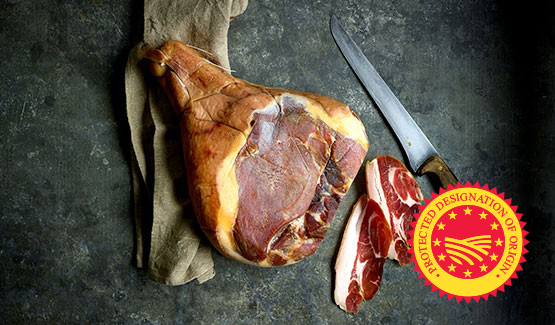Who hasn’t heard of Parma ham, or Prosciutto di Parma PDO? This raw, aged Italian meat can be found in delis and restaurants around the world. You have probably been offered it with a slice of melon during summer or as a topping on an Italian pizza. Its unique flavour comes from a mix of traditional know how and unique ecological and environmental conditions, specific to the Region of Parma, Italy.

Origins
All good Prosciutto di Parma PDO starts with the right pig. In central-northern Italy, the breeding of heavy pigs, used for this type of ham, developed over time from the Etruscan period (between eighth and third century BCE) to today. This evolved in parallel with the development of cereal and dairy farming in the same region, a core aspect of feeding. And ecco - the famous Italian ham was born.
While the area of production, which gives the ham its unique characteristics, is restricted to the Province of Parma, the raw materials can originate from a wider area that includes the regions of Emilia-Romagna, Veneto, Lombardy, Piedmont, Molise, Umbria, Tuscany, Marche, Abruzzi and Lazio.
Production
Only certain breeds of heavy pigs can be used to make prosciutto, such as the traditional breeds Large White, Landrace or Dunroc. Other breeds can be used as long as they are compatible with the Italian Herd Book. The pigs, at least nine months old, should weigh about 160 kg and be fed according to a specific regime.
The pigs go through multiple markings to certify their origin, starting with one by the breeders within thirty days of birth. When sent to slaughter, breeders issue a certificate of conformity. Slaughterers then affix a stamp with the identification code of the slaughterhouse on the fresh hind legs intended for the production of Prosciutto di Parma PDO.
To cure the legs, they are rubbed with salt at the production site. Before the salting starts, a metallic seal bearing the start date of production is fixed on the leg. They are then refrigerated for about a week. The salt is removed, to then add another thin layer of salt leading to another resting period of 15 to 18 days. The hams are then hung for approximately 80 days, in a room that ensures adequate ventilation and temperature.
After 80 days the hams have dried sufficiently. The harden surfaces are softened by a layer of pig fat spread on the ham (sugnatura). Once this is done, the hams are left to finish the curing process in dark cellar-like rooms. The curing should last a minimum of 12 months.
After 12 months, quality testing takes place, poking the ham in five specific places to help determine if the product is truly Parma ham quality. If it passes the test, the word PARMA in a five-point crown is heat affixed on the ham, under the supervision of an officer from the monitoring body.
The ham is then ready for packaging, whole, cut or sliced. Whichever form it will be sold, this needs to be done in the geographical area of origin – the Province of Parma.
More information
Prosciutto di Parma PDO – legal specifications



